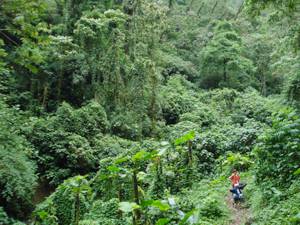Costa Rica is Still 50% Rain Forest

Abraham, our giant tree in the primary forest near Fortuna. The platform hangs 110 feet above the jungle floor - above most of the trees, where we watch, hear, and smell nature around us -- as we are eating lunch
Volare's Unique Access to Private Primary and Cloud Forests
Most of the thousands or rainforests in Costa Rica are secondary — younger trees, dense undergrowth, and younger forest - the average tree age is about 40 years. Secondary rainforests grow where the primary rainforest can't survive — Mother Nature limits life with floods, gravity-induced landslides, wind storms, or (unlikely in the tropics) lightning fires. A secondary rainforest does not feel very different from a Michigan or New England woods, except the species are different.
Very few primary rain forests remain in Costa Rica because these forests require relatively flat land -- terrain ideal for farming. Before the word "environmental" was coined, flat rainforest everywhere was cleared for crops and cattle. Costa Rica now strongly protects the few remaining primary forests - it is absolutely prohibited to cut forest trees.
Primary forest is undisturbed - by man and Nature - for centuries. It is primary rainforests -- the classic jungle of Tarzan movies — huge trees, a vast, cavernous canopy, vines hanging from massive branches -- that people see in their imaginations.
Both primary and secondary rainforests are habitat for thousands of species of animals. Visibility in a primary rainforest is easier because the canopy is more “vaulting” and the terrain below supports only shade species, which tend to be short and widely separated.
Serendipity built a platform suspended 110 feet above the jungle floor in a private primary forest. We use the platform to experience nature up with the birds and monkeys, above the canopy surrounding the giant tree.. and to eat lunch.
We named our tree Abraham in honor of the father of Judaism, Christianity, and Islam, because the 5 of us building the platform were of those three religions, working together.

Volare's favorite small private cloud forests allow excellent privacy, and let you explore at your own pace.
Cloud Forests
 Cloud forest is cool forest, mountainous, that is frequently blanketed in low level clouds. Because it is found only in tropical countries at high elevation (5,000 to 8,000 feet), each cloud forest is ecologically remote, separated even from other cloud forests in the same area, like islands sticking skywards between lower altitude landscapes.
Cloud forest is cool forest, mountainous, that is frequently blanketed in low level clouds. Because it is found only in tropical countries at high elevation (5,000 to 8,000 feet), each cloud forest is ecologically remote, separated even from other cloud forests in the same area, like islands sticking skywards between lower altitude landscapes.
Cloud forests act like siphons to catch passing clouds and create fresh water... and endless waterfalls and streams.
Cloud forests host many bird and animal species not commonly found in lower elevations (think "Gorillas in the Mist" and you are thinking cloud forest). Plant forms in cloud forests are nearly identical to fauna found in the era of dinosaurs — essentially not evolved from the earliest fern plants. These primitive plants, grown to gigantic sizes, combined with the misty air, the waterfalls, the solitude — it is an ethereal experience for nature enthusiasts.
Volare prefers cloud forests less popular than famous destinations like Monteverde. In these private small enclaves we have unrushed access to trails and waterfalls, and can walk at our own pace. The lodging is more primitive but the tradeoff for the serene nature is worth a small inconvenience.

Old growth rainforest has hundreds of species, a rich variety of flora -- and fauna.
Virgin Rain Forests
Simply, "virgin" means never cut or destroyed by humans. It can apply to any forest that has original growth, in any part of the world.
It's time to call us.
